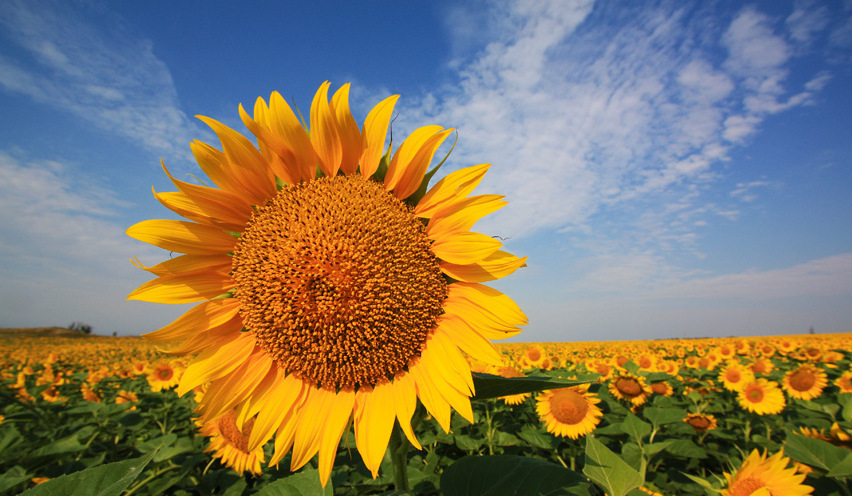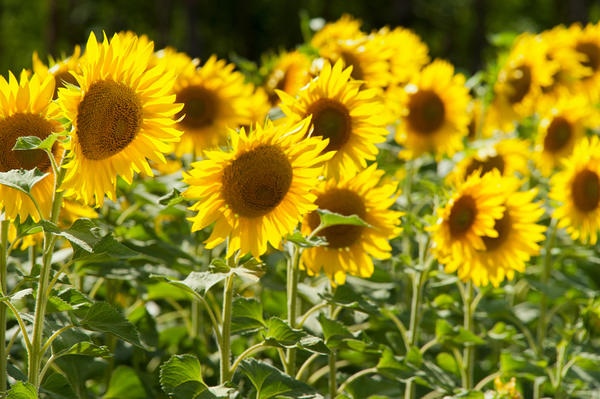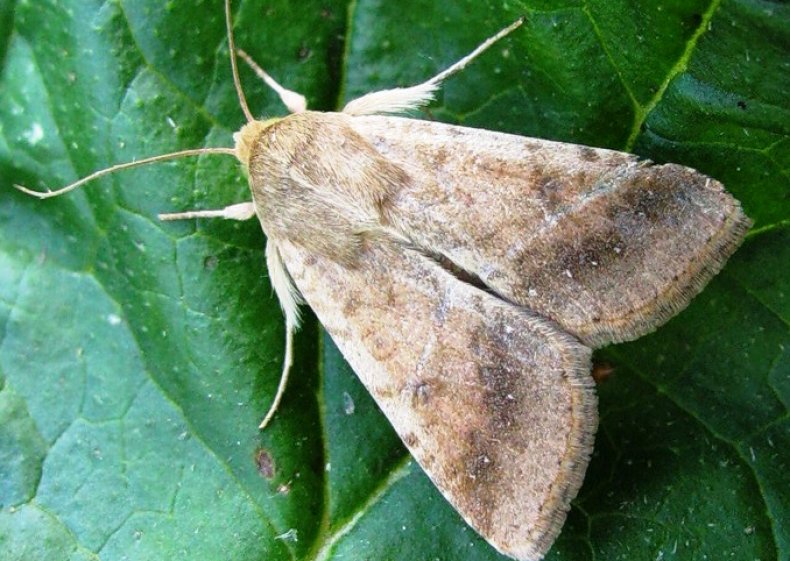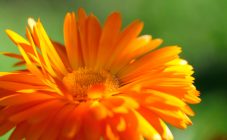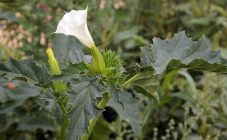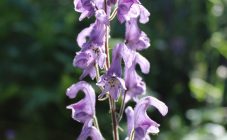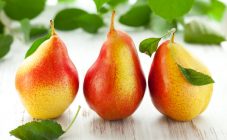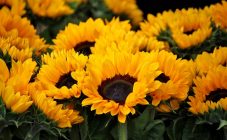Content:
The fields on which the sunflowers grow are eye-catching, many people immediately want to take several pictures against the background of such amazing beauty. Inflorescence petals outwardly resemble the sun from a child's drawing. This miracle of nature amazes not only with its magnificent appearance, but also with its useful properties.
North America is considered the homeland of sunflower, and the production of sunflower oil began in England in the second half of the eighteenth century. Since that time, breeders have bred many varieties of sunflower, which are highly resistant to various diseases and pests.
What is a sunflower and what does it look like
The annual sunflower, or sunflower, is a healthy oilseed crop that is grateful and responsive to good care.
No matter what the weather is outside, a plant similar to the sun will help create a warm and bright atmosphere in any garden plot.
Where do sunflowers look and why does a sunflower turn towards the sun? This phenomenon is typical only for young plant flowers that have not yet fully developed. The unopened sunflower bud really moves towards the sun throughout the day. This is due to the uneven growth of the stem, the phenomenon is called "heliotropism".
Sunflower cultivation is possible in any fertile land, and the resulting raw materials are further used in the process of cooking vegetable oil. In addition, the culture acts as a medicinal, ornamental and melliferous plant.
The annual sunflower belongs to the Asteraceae family. Its root system is rapidly developing to a depth of at least 150 cm (sometimes this figure reaches 5 meters), and up to 120 cm in width.
Among the main distinguishing features of sunflower are:
- tall, woody stem, covered with fine hairs, reaching a height of 4 meters;
- large leaves have an oval heart-shaped shape and pointed tips;
- the sunflower inflorescence is represented by a multi-flowered basket - its diameter is 20 cm, the disc of the basket is flat, and the hook is slightly convex;
- flowers are located at the edges, are reed and asexual, their shade is yellow-orange;
- as for the middle flowers, their size is much smaller, they are tubular and bisexual.
A mature plant has a lot of seeds. An annual herbaceous crop has an achene-fruit containing a shell and a nucleus. The composition of sunflower seeds contains oil in the amount of 30%, for representatives of elite varieties the indicator can be more than 47%.
Among the advantages of the annual culture, there are excellent medicinal properties - anti-inflammatory and astringent.
Where do sunflowers grow in the Moscow region? This question is often of interest to those who choose places for staged photo shoots and beautiful shots. People on various forums write that they saw fields with sunflowers in the following places:
- if you go from Khotkoy to Sergiev-Posad through Semkhoz (by car), then on the way you will come across such a field;
- a small sunflower field is located near the Danone plant;
- there is a huge field of sunflowers along the Simferopol highway before reaching Podolsk - it is difficult to drive them;
- on Novorizhskoe highway near Mansurovo.
It should be remembered that in the Moscow region it is best to shoot sunflowers from the end of July, during their flowering period.
Distinctive features and description of sunflower varieties
The annual plant has a wide variety. There are a large number of sunflower hybrids that are actively cultivated to this day and fully meet the detailed step-by-step criteria and requirements of industrial production.
Varieties can be both mid-season and early-maturing, and ten-petalled ornamental. The latter can be used to decorate a park or garden area. Among the early maturing perennial varieties, the following can be distinguished:
- Sunflower Albatross, which has a fairly high oil content. The variety is drought-resistant, resistant to pests and various diseases. Feels great with extensive growing methods. It reaches a height of 2 meters.
- Sunflower Buzluk, the seeds of which contain up to 55% oil. This variety has a stable yield, independent of weather conditions, and a high rate of drought resistance. When growing Buzluk, it is necessary to observe high-quality agricultural technology and fertilize regularly. This subspecies grows up to 170 cm in height.
As for the mid-season varieties, there is a variety called Favorit: it has a high oil content - up to 55%. The variety is not afraid of hydrolytic decomposition, because its seeds are distinguished by a low acid number. The height of the plant, on average, is 2 m. Among the varieties with high yields, the Flagman and the Master also stand out. In the process of their cultivation, it is necessary to periodically apply the appropriate mineral fertilizers.
Tuberous sunflower, better known as Jerusalem artichoke, is presented as a technical, fodder or decorative crop. For optimal plant growth, areas of the southern climatic zone are most suitable. This fact is due to the fact that it ripens only in September-November (depending on the specific variety). The yield indicator of tuberous sunflower reaches 35 tons of tubers, which can be harvested from one hectare of land.
Properties and useful qualities of culture
Sunflower has a number of beneficial properties that arise from its unique chemical composition. Vegetable oil rich in oleic and linoleic acids is obtained from the seeds of the culture. With the help of sunflower oil, you can get rid of cholecystitis, as well as biliary dyskinesia. In addition, we must not forget that this product is widely used in cooking.
The composition of sunflower seeds includes the following elements:
- glycosides;
- skopolins;
- phenol carboxylic acids;
- carotenoids and anthocyanins.
Sunflower seeds contain magnesium, the amount of which is six times higher than that in rye bread.
Due to the content of calcium, zinc, iron, iodine and fluoride, the plant is often used in the preparation of various additives and products that can be used to care for the skin of the face and body. Shampoo, lipstick, hygiene products for children - sunflower oil can be found in these and many other products. This oil also contains a large amount of vitamin F, which nourishes and moisturizes the skin, and also nourishes the hair and nails.
Sunflower can have a positive effect on a person suffering from diabetes. Tea made from the leaves of this culture has expectorant, diuretic and astringent properties. The petals can be used to make poultices to help with wounds, spider bites and snake bites.
In the culinary industry, sunflower is often used in the baking process. The seeds must first be fried and chopped, and the resulting consistency must be used for baking cookies as a filler. In Great Britain, young plant baskets were used to prepare vitamin salads with vegetables.
From the pollen that bees get from the inflorescences of a honey-bearing sunflower, you get very tasty honey, which even bears love to feast on.
What pests are and how to deal with them
The pests that pose a particular danger to sunflower in the Moscow region are:
- sunflower spikelet;
- cotton scoop;
- aphid.
In order to lay eggs, the spiker uses the axils of the sunflower leaves. The yellow larvae have a brown head and three pairs of legs that cover long hairs. The larvae penetrate the core of the plant, breaking through their own passages from different sides. They feed on the stem, eating a third of it, and with the onset of autumn they become pupae and hibernate. It is possible to fight the thorns by resorting to timely harvesting and deep plowing. Treatment of the plant with Vantex also helps.
The main plant pest is the cotton moth, whose wingspan is 40 mm. The color of its front wings is yellow and gray, and the hind ones are light in color, separated by a burgundy stripe. A dark spot can often be seen in the center of the hind wings. The length of the caterpillar of the cotton scoop is 40 mm, and its color can be either light green, or brown or yellow. To combat the cotton bollworm, farmers advise not to neglect deep autumn plowing, timely weed control and proper tillage between the rows of plants.
As for the aphids, they nibble on the sunflower. This often occurs at elevated air temperatures or prolonged drought. The main part of insects feed on ladybugs, so aphids do not cause significant damage to the culture, and there is no need to process the plants using chemicals.
Possible harm and contraindications
Due to individual intolerance to sunflower, the human body can be harmed.
It is not recommended to resort to the sunflower treatment method if insoluble stones are present in the body.
Despite all the beneficial qualities of sunflower oil, it should not be eaten in large quantities, as this very often leads to intestinal disorders.
Sunflower fields in the Moscow region are the brightest, most picturesque and cheerful decoration of any landscape, even in inclement weather.To decorate your personal plot and create the same cozy and light atmosphere, you can use decorative annual sunflowers, characterized by full yellow inflorescences, in which there are practically no seeds. With the help of such an unpretentious shrub, the garden is filled with light, solar energy and freshness.

